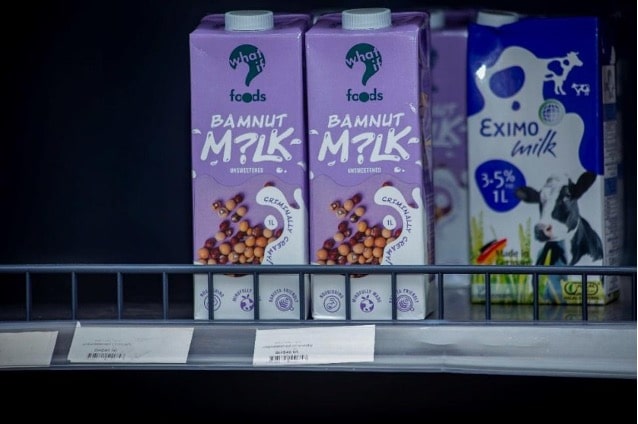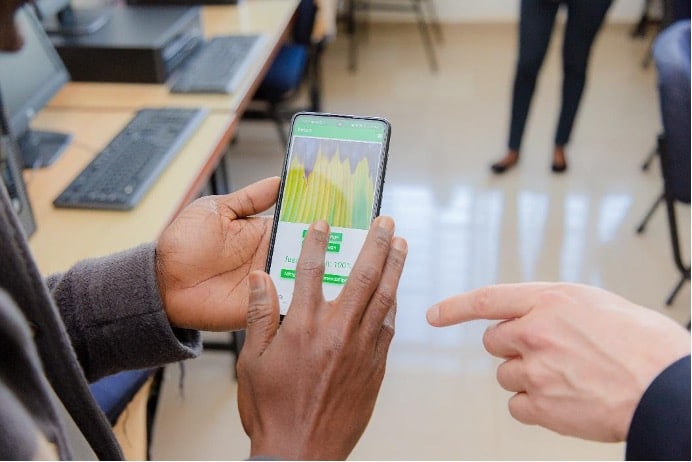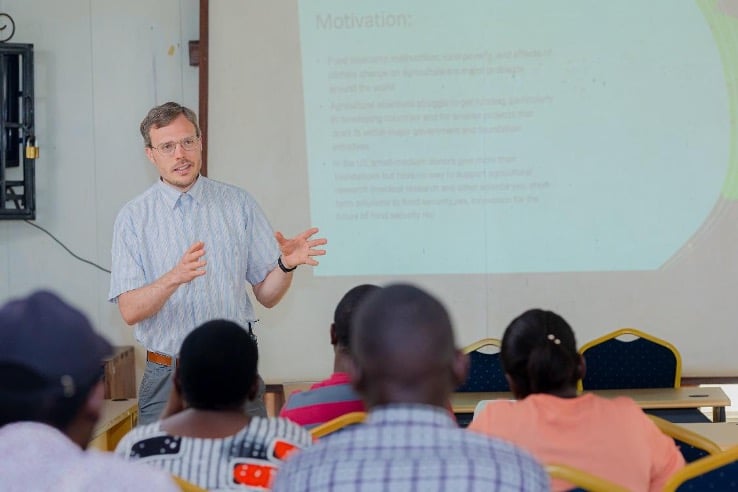It’s been a long, tough, but carefully plotted journey for Grow Further on our mission to transform the way agricultural research and development is funded. Along the way, we’ve met and spoken with a great number of inspiring crop scientists and entrepreneurs to learn more about their visions for improving the livelihoods of smallholder farmers everywhere.
Now, the rubber is about to hit the road.
After years of carefully building up our governance, staffing, and membership network, Grow Further is very pleased to announce the recipients of our first two grants in support of agricultural research. These grants are awarded to organizations working on innovative and overlooked projects that can potentially transform smallholder agriculture, improve nutrition, and help beat back food insecurity. The grants, made possible through the generosity of individual donors (rather than giant government aid agencies), will support research to unleash the power of a key underutilized crop and arm smallholder farmers with technology that will help them defend their fields from pests and diseases. Below, we proudly introduce you to the first two Grow Further grant recipients.
Forging new ground for an unknown groundnut

In 2001, the United Nations Food and Agriculture Organization commissioned a report to study the feasibility of expanding the cultivation of Vigna subterranea, aka the Bambara groundnut. The UN agency identified this “underutilized African legume” as a food crop of real potential; it also chose the Bambara groundnut as a case study in finding ways to popularize other so-called forgotten foods, lamenting how most of the world’s population is sustained by fewer than 20 species of crops.
Rich in protein and other nutrients, the Bambara groundnut is a hardy plant that can grow in harsh arid climates. However, as the authors of the report noted, “The agroecological and genetic potential of Bambara groundnut has not yet been fully realized, nor its full economic significance determined. The crop is still cultivated from local landraces rather than varieties bred specifically for particular agroecological conditions or production systems.”
Now, Grow Further is aiming to address that very obstacle by developing a commercial cultivar, in partnership with the Council for Scientific and Industrial Research-Savanna Agricultural Research Institute (CSIR-SARI), one of our first grant recipients.
Plant disease diagnosis? There’ll be an app for that

The Nelson Mandela African Institution of Science and Technology (NM-AIST) was founded in 2010 in the northern Tanzania city of Arusha. Said to be the “proud brainchild” of its namesake, the late South African President Nelson Mandela, the institute’s mission statement on its website says it was established for “training and developing the next generation of African scientists and engineers with a view to impacting profoundly on the continent’s development.”
One key area of NM-AIST’s focus is smallholder agriculture and finding ways for the continent’s smallholder farmers to see greater success in growing the food their neighbors need to survive. Not too long ago, Dr. Neema Mduma, a lead researcher at NM-AIST, welcomed Grow Further founder and CEO Peter Kelly on a tour of their facilities and test fields. Still exhausted from a visit to northern Ghana, Peter nevertheless ventured to Arusha, Tanzania to get a first-hand look at the smartphone application that Dr. Mduma says will help farmers detect the earliest signs of crop disease, buying them time to head off these threats and defend their crops.
After a careful review, a focus group discussion, and lengthy conversations held in and around Arusha, Peter returned to the United States convinced that the professionals at NM-AIST are worthy partners for Grow Further’s mission. Our board and member donors agreed. We’re pleased to announce that NM-AIST is also a recipient of a Grow Further grant in our first-ever grant distribution round.
What we discovered in Ghana and at CSIR-SARI
Peter says V. subterranea has a taste and texture similar to chickpeas, and those are already widely consumed—crush and whip up chickpeas, then add olive oil, and you have hummus, a staple of Mediterranean cuisine. CSIR-SARI, Grow Further’s partner in this adventure we’re about to set out on, showed us how Bambara groundnuts can be processed to make a tasty plant-based milk. But first, CSIR-SARI will need to develop and cultivate better varieties of this hearty legume, perhaps the very ideal varieties that eluded FAO.
Peter traveled thousands of miles from his base in Seattle to northern Ghana to meet with the good folks at CSIR-SARI, to see for himself what they have in mind and whether they can make the most of Grow Further members’ financial support. He came away from the meeting impressed and confident that the team at CSIR-SARI is indeed a worthy recipient. CSIR-SARI is excited to begin work on the the first commercial variety of Bambara groundnuts–long overlooked by other funding sources–and to work with us as research collaborators on program evaluation.
Upon setting out on the search for the perfect Bambara groundnut variety, the folks at CSIR-SARI said they quickly identified the same problem that FAO ran into two decades earlier. “Just like other underutilized crops, there are no improved varieties of Bambara groundnut released for production in Ghana,” wrote Alhassan Nuhu Jinbaani in CSIR-SARI’s grant application. “Locally available landraces remain the main source of planting materials used by farmers for production.” Meaning Bambara groundnut cultivation is hyper-local—no varieties have been developed that might enjoy broader geographic appeal. We hope that’s about to change.
While in the northern Ghana hub of Tamale, Peter toured the CSIR-SARI labs that will be used in the Bambara groundnut project. He then ventured farther afield to a rural region near the border with Burkina Faso. There, he viewed one of CSIR-SARI’s Bambara groundnut test plots.
Lab testing and field trials are just two pieces of the organization’s broader plan to succeed where FAO dropped the ball. Their project will begin with a detailed household survey to understand what farmers want in Bambara groundnuts, which as Peter found talking to women farmers isn’t always what one might expect. In addition to breeding, the project will conduct agronomic research on how best to manage Bambara groundnut plantings and establish “innovation platforms” in 20 districts in northern Ghana to help the new cultivar to become established with the help of government and private-sector partners. There’s a lot of work ahead, but also a lot of potential.
Insights from Tanzania
Arusha is famous for hosting international conferences and events, so it’s more cosmopolitan than Tamale, as Peter discovered during his travels there.
NM-AIST is a graduate university, where Mduma and colleagues introduced Peter to faculty and administrators and toured a beautiful campus in perfect weather. But the most interesting parts of the visit were talking to farmers and seeing the problems the project is designed to address first-hand. Through an interpreter, Peter spoke with farmers, many of whom cannot afford smartphones, asking them whether the project would be useful and how it might best be designed to meet their needs. Then he got a first-hand look at the devastation that pests and diseases can wreak on maize in the area.
As envisioned, NM-AIST’s app will analyze photographs of maize and common beans, alerting farmers to early signs of crop diseases. The machine learning-powered digital tool will sort through a huge database of images of crop illness to detect what maladies are beginning to assert themselves in farmers’ fields. But that’s not all. The app will also give farmers advice on how to best address or isolate these threats, to ensure a whole harvest isn’t lost. NM-AIST plans to work with agricultural extension services, farmer associations, and other stakeholders to take the idea to the masses, as well as sharing their data with researchers in other regions. But first, the app must be trained, built, and tested, and this work will require money. Grow Further is happy to lend a hand.
We congratulate our first-ever grant recipients
The CSIR-SARI research team can’t wait to release the first commercial variety of Bambara groundnuts and revolutionize the cultivation of the crop. They will receive $133,000–which goes a long way in northern Ghana–from Grow Further over 3 years.
The NM-AIST team proved their willingness to listen to suggestions and adapt in ways that will make their research plans more inclusive, improving chances for success. NM-AIST will receive $63,000 from Grow Further to cover two years of work to develop and disseminate the smartphone app.
— Grow Further
Photo credit: Photo of Bamnut Milk on sale at a shop in Tamale, Ghana courtesy of Kwekwe Photography. Photo of a new smartphone app under development courtesy of True Vision Productions.




